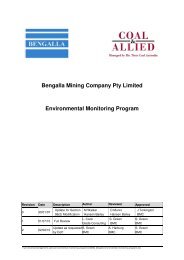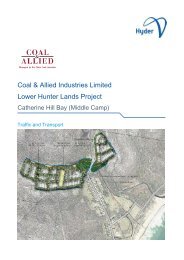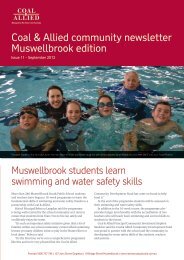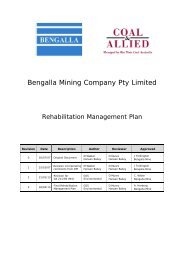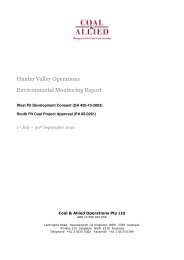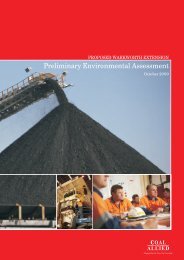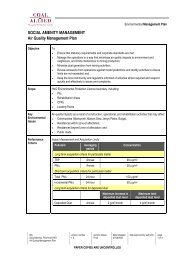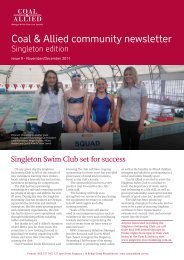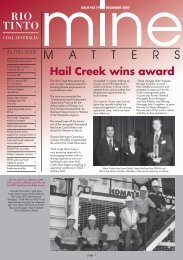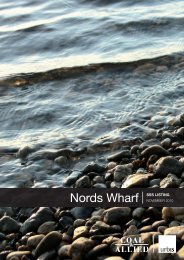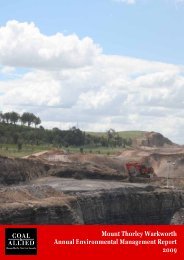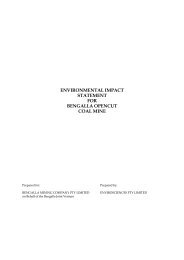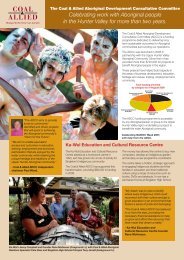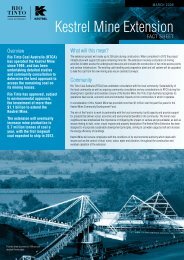HVO 2009 Annual Environmental Management Report - Final
HVO 2009 Annual Environmental Management Report - Final
HVO 2009 Annual Environmental Management Report - Final
You also want an ePaper? Increase the reach of your titles
YUMPU automatically turns print PDFs into web optimized ePapers that Google loves.
Coal & Allied – Hunter Valley Operations<br />
improvement across the four sites. Regardless all sites maintained a moderate health status and revealed no<br />
further disturbance or evidence of the 2006 fire. Monitoring of the sites will remain an ongoing process.<br />
Each site was then ranked according to the above mentioned categories. For woodland sites a score of 95 indicated excellent condition. For pasture sites a score of 70 indicated excellent condition. The scores for pasture sites are lower due to the absence of<br />
overstorey and understorey vegetative components.<br />
Site one (Burnt pasture) scored 45, a decrease from 53 in 2006. Site two (Burnt woodland) scored 52, a<br />
decrease from 66 in 2006. Site three (Unburnt woodland) scored 52, a decrease from 67 in 2006. Site four<br />
(Unburnt pasture) scored 43, a decrease from 55 in 2006. All four sites have exhibited a reduction in scores<br />
since the 2006 monitoring round, however still fall within the “satisfactory” condition range. Factors which<br />
influenced the lower scores include;<br />
<br />
<br />
Increase in introduced species (weeds) across the entire site;<br />
Absence of understorey vegetation; and<br />
Decrease in ground cover species diversity and abundance.<br />
Sites will be re-assessed in 2010 to continue the monitoring programme.<br />
3.16 MINE SUBSIDENCE<br />
<strong>HVO</strong> currently utilise open cut mining techniques that do not result in subsidence of the surface. <strong>HVO</strong> have no<br />
active underground workings.<br />
3.17 HYDROCARBON CONTAMINATION<br />
3.17.1 <strong>Environmental</strong> <strong>Management</strong><br />
<strong>Management</strong> of petroleum hydrocarbon contaminated soil is ongoing at <strong>HVO</strong>. The current technique employs<br />
the use of a bioremediation area that is maintained and operated in accordance with Coal & Allied<br />
procedures.<br />
Contaminated soil is taken to the bioremediation area and placed in batches based on the time of<br />
contamination. To maximise air circulation, contaminated soil is spread out in windrows of no more than<br />
approximately 300mm in height and approximately a grader width at the base. Windrows are oriented north<br />
south to achieve maximum exposure to sunlight. NPK fertiliser or farm manure is applied to increase the<br />
population of degrading bacteria. The windrows are tined by a grader or equivalent on monthly intervals in<br />
order to provide aeration for the microbes.<br />
Soil in the treatment area is sampled and tested every three months until total hydrocarbon levels are less<br />
than 1,000ppm. Soil meeting the criteria may be removed and used for top dressing purposes or disposed of<br />
in the spoil dump.<br />
3.17.2 <strong>Environmental</strong> Performance<br />
Bioremediation Area<br />
The <strong>HVO</strong> bioremediation area is monitored for contaminants and turned regularly throughout the year. Test<br />
results showed that the hydrocarbon levels in the material improved over the year. Three cells of material<br />
were removed from the bioremediation area during <strong>2009</strong> and placed in West Pit for use in future<br />
rehabilitation.<br />
During <strong>2009</strong>, the in pit fuel tankers in West Pit were decommissioned and removed. <strong>HVO</strong> is currently<br />
remediating the site of the old fuel tankers in accordance with the NSW EPA 1994 sensitive land use criteria<br />
and will receive a report from external consultants during 2010 regarding the success of the remediation.<br />
AEMR <strong>2009</strong> 146



